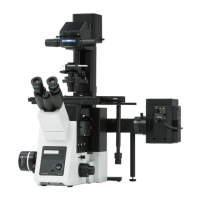43
IX73
5-3 Simplified Polarized Light Observation
a
d
b
when using IX-LWPO
when using IX3-LWUCDA
c
d
when using IX3-LWUCDA
} Use the same procedure as that for attaching the analyzer and
polarizer for DIC observation.
} The simplified polarized light observation is enabled also by attach-
ing the analyzer U-ANT to the dummy slider.
Rotate the turret for the BF (brightfield) light path (with no optical ele-
ment engaged in the light path).
When IX3-LWUCDA is used, push the button
a
of IX3-LWUCDA to
engage the polarizer in the light path.
When IX-LWPO is used, move the polarizer detaching lever
b
on
the IX-LWPO polarizer to engage the polarizer in the light path.
Rotate the revolving nosepiece to engage the objective to be used
in the light path.
Refer to page 39 and engage the analyzer in the light path.
When IX3-LWUCDA is used, loosen the polarizer rotation knob
d
by rotating the clamping knob
c
in the clockwise direction until
the knob stops.
When IX-LWPO is used, loosen the clamping of the polarizer rota-
tion/clamping knob by rotating slightly the polarizer rotation/clamp-
ing knob
d
in a counter-clockwise direction.
Move the polarizer rotation/clamping knob
d
on the polarizer unit
horizontally in the counterclockwise direction around the axis until
the position in which the field of view is darkest.
After determining the position, clamp the polarizer.
When the IX3-LWUCDA is used, rotate the clamping knob
c
in
the counterclockwise direction around the axis until the knob is
stopped.
When the IX-LWPO is used, rotate the polarizer rotation/clamping
knob
d
in a clockwise direction until the knob stops.
Place a specimen on the stage and bring the specimen into focus.
Now the specimen can be observed with simplified polarized light
observation.
Adjust the field iris diaphragm so that its image circumscribes the
field of view.
Adjust the aperture iris diaphragm to enhance the contrast.
} If you use 1.6X or 2X of IX3-CAS for the simple polarized light obser-
vation using IX3-AN, the contrast may be difficult to view in some
cases.
1
2
2
3
4
5
6
7
8
9
10
1
Attaching the Analyzer and Polarizer
2
Observation Method

